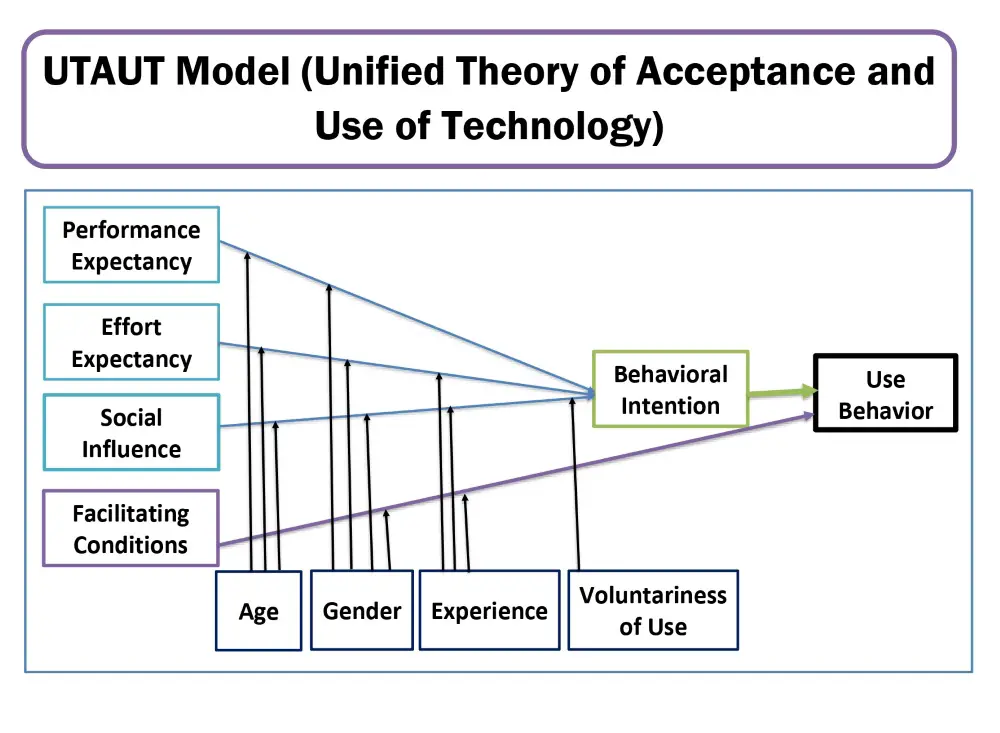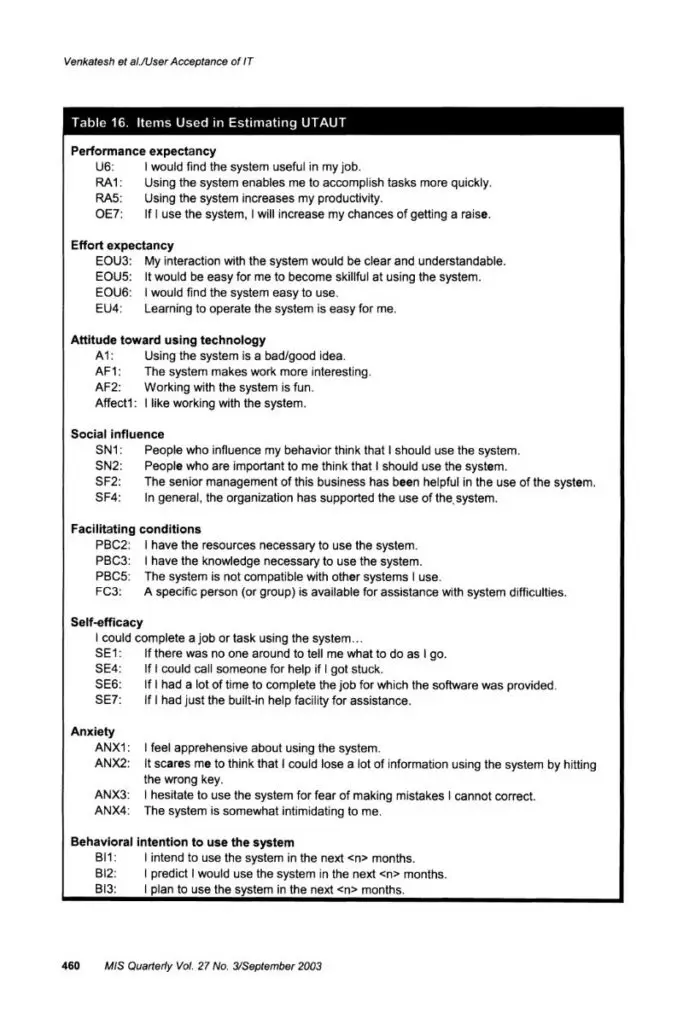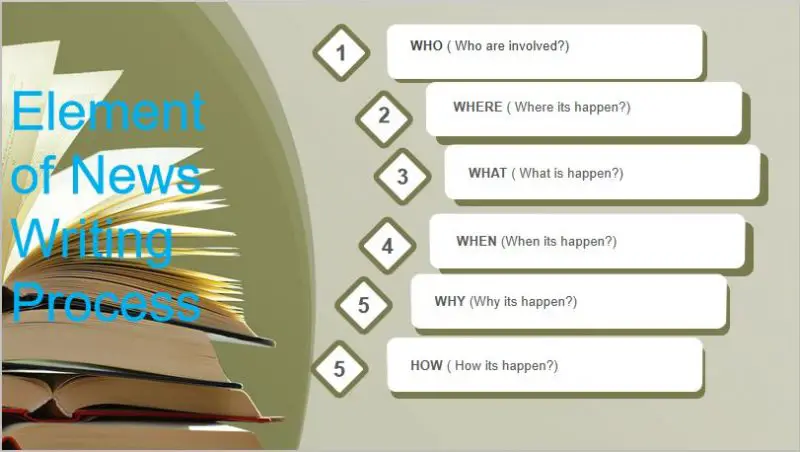This article explains The UTAUT Model or Unified Theory of Acceptance and Use of Technology and its Variables, Questionnaires, Examples, Strengths, and Limitations. It also demonstrates the UTAUT Model Venkatesh Questionnaire.
UTAUT Model
UTAUT model refers to the Unified Theory of Acceptance and Use of Technology Model developed by Venkatesh, Davis, Morris, and Fred D. Davis in 2003. UTAUT is the short form Unified Theory of Acceptance and Use of Technology. The unified theory of acceptance and use of technology (UTAUT) is one of the most updated and accepted technology adoption models. This study was conducted in longitudinal qualitative research that found around 70 percent of Behavioural Intention to Use (BI) and about 50% in actual use.
Viswanath Venkatesh and other authors proposed this theory based on the review of eight models that examine factors affecting the usage behavior of information systems. It is an extended theory of the eight-technology adoption models. The authors mentioned the eight theories in the paper’s abstract section. The eight models are as follows:
- Theory of Reasoned Action (TRA)
- Technology Acceptance Model (TAM)
- Motivational Model (MM)
- Theory of Planned Behavior
- Combined Theory of Planned Behavior/Technology Acceptance Model
- Model of Personal Computer Use
- Diffusion of Innovations Theory (DIT)
- Social Cognitive Theory (SCT)
The authors collected and used data from four organizations over six months to observe and record changes in variables. The data were analyzed through three points of measurement. Based on the literature study on user acceptance, the UTAUT model is broadly popular in identifying factors that influence users to adopt new technology and information systems. Venkatesh et al. (2003) mentioned the four constructs that directly and indirectly determine the user’s system use motivation. The three constructs (1. Performance Expectancy, 2. Effort Expectancy, and 3. Social Influence) determine the intention to use the technology through behavioral intention. The fourth characteristic (Facilitating Conditions) directly determines the intention to use the technology. The UTAUT model also presents four moderator variables (Age, Gender, Experience, and Voluntariness of Use).
UTAUT Model Basic Info
Authors: Viswanath Venkatesh, Michael G. Morris, Gordon B. Davis, and Fred D. Davis
Title: “User acceptance of information technology: Toward a unified view”
Publishers: Management Information Systems Research Center, University of Minnesota
DOI URL: https://www.jstor.org/stable/30036540
Research Strategy: Survey
Methodological Choice: Mono-method Qualitative
Time Horizon: Longitudinal
The Management Information Systems Research Center, University of Minnesota published the UTAUT model in 2003 under the title of USER ACCEPTANCE OF INFORMATION TECHNOLOGY: TOWARD A UNIFIED VIEW.
Unified Theory of Acceptance and Use of Technology (UTAUT) Model
Previous research validates the unified technology acceptance and use of technology theory as a comprehensive theoretical model to predict the adoption intention of new technology and systems in different contexts. Consequently, the UTAUT model certainly provides an in-depth understanding of factors that predict individuals to accept and use new systems or tools. The UTAUT model describes why and how users adopt new systems and technology. This theory proves that performance expectancy, effort expectancy, facilitating conditions, and social influence influence people to use new systems in social and organizational contexts.
Many researchers extended this theory to understand factors influencing to acceptance of new systems in different contexts. For example, In 2012, Venkatesh, L. Thong, and XinXu extended the UTAUT) model to study the acceptance and use of technology in a consumer.

Determinants of the Unified Theory of Acceptance and Use of Technology (UTAUT) Model
The UTAUT model comprises four independent or predictor variables (1. Performance Expectancy, 2. Effort Expectancy, 3. Social Influences, 4. Facilitating Conditions), four moderators (1. Age, 2. Gender, 3. Experience, 4. Voluntariness of Use), and dependent variable (Behavioral Intention).
The six core variables of the UTAUT model are:
- Performance Expectancy
- Effort Expectancy
- Social Influences
- Facilitating Conditions
- Behavioral Intention
- Use Behavioral
Performance Expectancy (PE)
Performance expectancy is a predictor variable that considers how the new system will assist users in improving performance to complete the task (Venkatesh et al. 2003). It validates why the new system is advantageous for individual performance and improves efficacy. It also simulates the decision-making process of why they use the system. In a social context, people accept new technology when got benefit from it. Performance expectancy describes the importance of new systems and technology, influencing a person to use the latest technology. Based on the UTAUT model, the researcher can hypothesize that when people consider new systems and technology as helpful tools, they will utilize them in personal, social, and professional contexts. In sum, Performance expectancy will influence users to accept and use the new system to complete a particular task positively.
Effort Expectancy (EE)
Effort expectancy is another crucial independent variable that considers how much the new technology will be easy and effortless to complete the tasks (Venkatesh et al. 2003). Researchers employ this construct to examine the level of ease of use. It represents the extent to which users determine how simple modern technology is to learn and operate. Effort expectancy demonstrates the easiness and effortlessness of using the new technology. People will adopt new technology if those tools are easy to use, affecting their decision to adopt a particular technology.
However, the users might not adopt the new system if it is challenging to operate and takes much time compared to the previous technique. Effort expectancy is a crucial factor in making adoption decisions at the beginning stage. According to the UTAUT model, people prefer to use new systems and tools that are easy to operate and system are clear and understandable. Based on the above discussion, the researcher can hypothesize that if people perceive that the new system is a trouble-free and effortless tool, they will adopt it in personal, social, and professional environments. Hence, Effort expectancy will influence new users to accept and use them positively.
Social Influence (SI)
Social influence is the degree to which users prioritize other beliefs that why they should utilize the new system (Venkatesh et al. 2003). It directly affects others’ behavioral intentions to adopt the technology. People change technology usage behaviors when considering that others benefit from the new technology (Peng & Miller, 2021; Mortenson & Vidgen, 2016). Social influence can come from friends, colleagues, family members, relatives, and managers. It happens at the initial stage when people are intended to meet their own and others’ expectations. For example, people adopt the WeChat tool for social media news use because they get recommended and suggested by peers. Based on the UTAUT model, researchers can hypothesize that people embrace new systems to complete particular tasks if they observe others utilize these systems for the same purposes. Therefore, Social influence will influence users to accept and use new tools positively.
Facilitating Conditions
According to the UTAUT model, facilitating condition is a degree to which an individual considers that the organization has infrastructural, resource, and technical support use of the new system. It ensures the organization’s capability to adopt the new tools to complete tasks. For example, IT companies can easily adopt artificial technology because they have skilled human resources and technology to use them properly. In this scenario, skilled employees, and modern technology facilitate the condition to use the new system.
Based on the UTAUT model, researchers can hypothesize that people utilize new systems to complete complex tasks if they observe that they have technical and infrastructural resources to operate them. Therefore, the Facilitating Condition will influence users to accept and use new tools positively.
UTAUT Model Venkatesh Questionnaire
Venkatesh and other authors used the following item to estimate the UTAUT model also known as the Unified Theory of Acceptance and Use of Technology (UTAUT) Model. However, the authors dropped the three determinants including self-efficacy, anxiety, and attitude from the model. Finally, they kept four determinants that play predicting role. The researchers have adopted these research questionnaires to conduct diverse research in different contexts.
For example, Abdullah M. Baabdullah adopted UTAUT model questionnaires to validate his research questionnaire estimating “The precursors of AI adoption in business.”

Item Used To Estimate UTAUT Model Hypotheses
Performance Expectancy
U6: I would find the system useful in my job. RA1: Using the system enables me to accomplish tasks more quickly. RA5: Using the system increases my productivity. OE7: If I use the system, I will increase my chances of getting a raise.
Effort Expectancy
EOU3: My interaction with the system would be clear and understandable. EOU5: It would be easy for me to become skillful at using the system. EOU6: I would find the system easy to use. EU4: Learning to operate the system is easy for me.
Attitude Toward Using Technology
A1: Using the system is a bad/good idea. AF1: The system makes work more interesting. AF2: Working with the system is fun. Affect1: I like working with the system.
Social Influence
SN1: People who influence my behavior think that I should use the system. SN2: People who are important to me think that I should use the system. SF2: The senior management of this business has been helpful in the use of the system. SF4: In general, the organization has supported the use of the system.
Facilitating Conditions
PBC2: I have the resources necessary to use the system. PBC3: I have the knowledge necessary to use the system. PBC5: The system is not compatible with other systems I use. FC3: A specific person (or group) is available for assistance with system difficulties.
Self-Efficacy (Dropped)
I could complete a job or task using the system... SE1: If there was no one around to tell me what to do as I go. SE4: If I could call someone for help if I got stuck. SE6: If I had a lot of time to complete the job for which the software was provided. SE7: If I had just the built-in help facility for assistance.
Anxiety (Dropped)
ANX1: I feel apprehensive about using the system. ANX2: It scares me to think that I could lose a lot of information using the system by hitting the wrong key. ANX3: I hesitate to use the system for fear of making mistakes I cannot correct. ANX4: The system is somewhat intimidating to me.
Behavioral Intention to Use the System
BI1: I intend to use the system in the next <n> months. B12: I predict I would use the system in the next <n> months. B13: I plan to use the system in the next <n> months.
UTAUT Model Limitations
The author has collected the following limitations and shortcomings of the UTAUT model from several top papers. Firstly, in this study, authors analyzed secondary data, not primary, which is this model’s limitation. Primary data are convenient for assessing mediators and moderators. The additional shortcoming of the UTAUT model is the variance of findings for utilizing a longitudinal research; because long-term studies might provide unexpected findings.
UTAUT Model Apa Citation 7th Edition
Venkatesh, V., Morris, M. G., Davis, G. B., & Davis, F. D. (2003). User acceptance of information technology: Toward a unified view. MIS Quarterly, 425-478.
